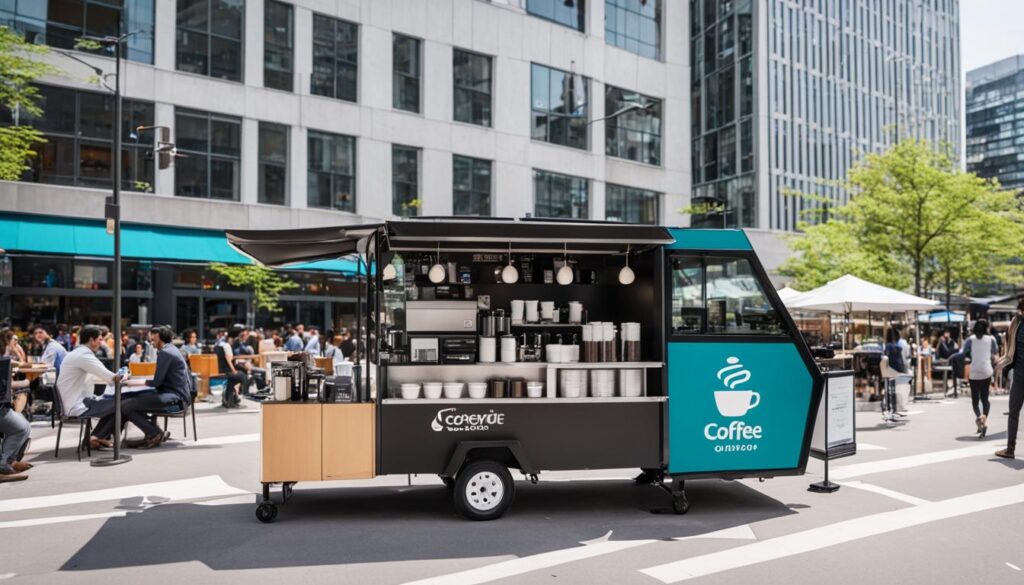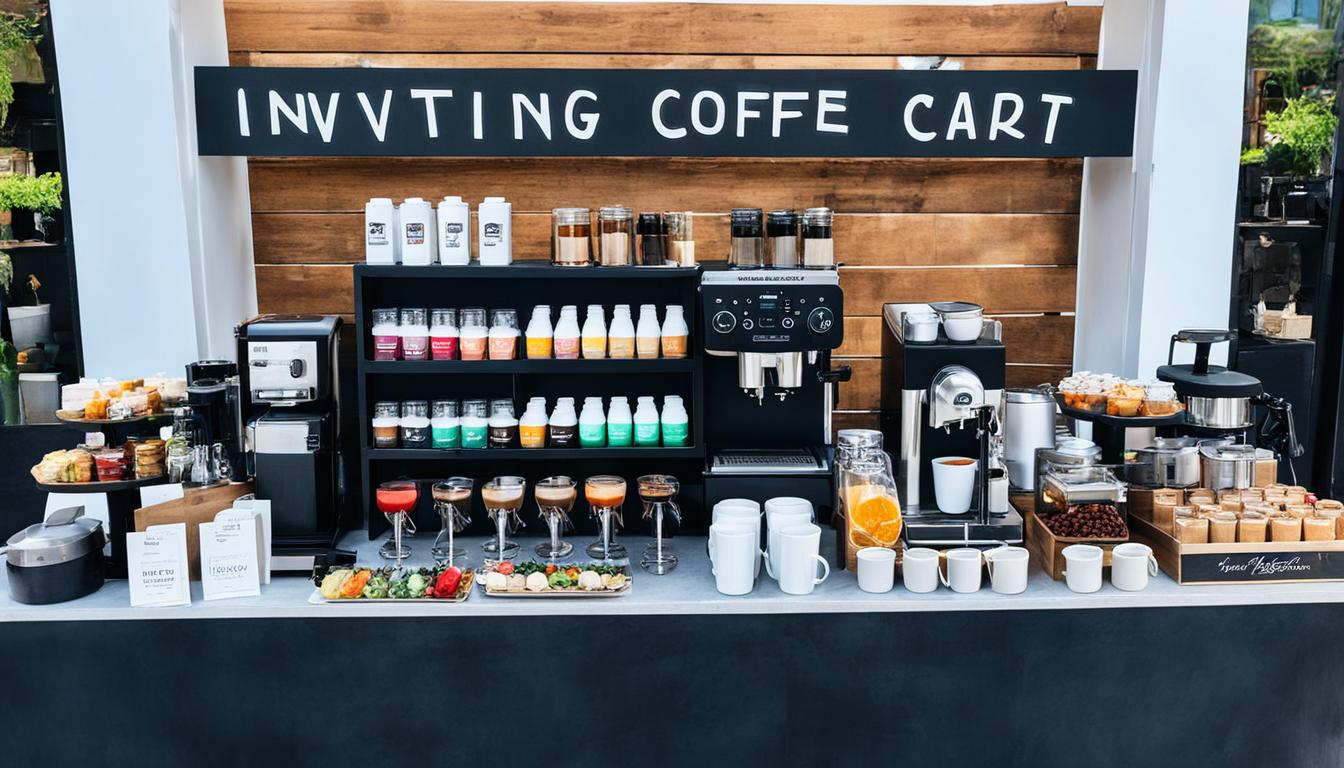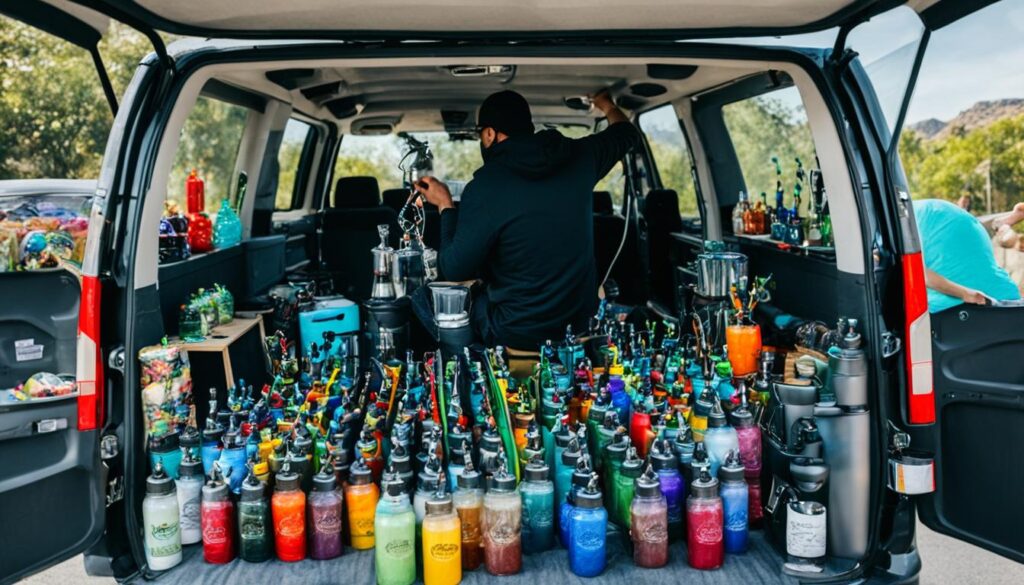Embarking on the journey to start a coffee cart business may herald the beginning of not just a lucrative venture but also an adventure into the vibrant world of coffee. As the aroma of freshly brewed espresso wafts through the morning air, your entrepreneurial spirit awakens. Starting down this path, you’ll realize that a coffee cart startup guide isn’t just about recipes and beans; it’s about connecting with the community, understanding local rhythms, and weaving into the fabric of daily life.
Before you plunge into the bustling dynamic market, a thorough understanding of setting up a successful coffee cart is essential. With lower initial costs and an appeal to the on-the-go lifestyle, your mobile bean haven can swiftly become the cornerstone of the neighborhood’s morning routine. But success lies in the details—location scouting, defining your brand, and creating a business plan tailored to your audience’s preferences. Keep close these profitable coffee cart business tips and let them be the compass that guides your enterprise to prosperity.
Key Takeaways
- Understand the potential and basics of launching a coffee cart business.
- Learn why coffee cart startups can be more viable than traditional coffee shops.
- Key considerations for creating a business plan that aligns with your market.
- Insights into the selection of a strategic location for maximum profit.
- Essential tips for branding and differentiating your mobile coffee venture.
Understanding the Coffee Cart Business Landscape
The concept of starting a mobile coffee cart is quickly brewing into a sought-after venture, as entrepreneurs recognize the vast coffee cart business opportunities that align with the dynamic lifestyles of today’s urbanite. If you’re contemplating diving into the world of mobile espresso bars, you’re tapping into an industry that rewards agility and innovation. In unraveling the coffee cart business essentials, it’s essential to assess both the profitable opportunities that await and the genuine challenges you may encounter.
The Opportunities and Booming Popularity of Mobile Coffee
The advantage of starting a coffee cart lies not only in the significant lower barriers to entry but also in the robust year-round demand for coffee. With more individuals appreciating quality brews on-the-go, mobile coffee carts are becoming a staple in public spaces, bustling streets, and special events. The profitable coffee cart business model boasts the agility to maneuver wherever the clientele is, making it an exceptionally versatile choice for entrepreneurs.
- Coffee cart business startup checklist
- Strategies for leveraging high-foot-traffic locations
- Understanding consumer behavior for on-the-go coffee consumption
Assessing the Advantages and Downsides of Coffee Cart Operations
Embarking on this journey offers numerous advantages, such as the reduced start-up costs when compared to opening a traditional café. However, ensuring success in a coffee cart business means facing and overcoming certain challenges. It’s about understanding the ebb and flow of daily traffic patterns, the competition with established coffeehouses, and the need for unparalleled product quality.
- Evaluating competition and carving out a unique value proposition
- Mastery of barista skills as a critical factor
- Implementing coffee cart business best practices to foster customer loyalty
While there are certainly challenges of a coffee cart business, your vision, paired with a strategic approach that includes a precise startup checklist and adherence to best practices, can lead to crafting a distinctive and profitable coffee cart business. Those who excel in this industry do so through relentless innovation, ongoing learning, and an unwavering commitment to delivering quality.
Navigating Legalities and Permits
Embarking on your coffee cart business journey means more than just serving a great cup of coffee; it’s about ensuring that you are compliant with coffee cart business legal requirements. Local laws can have unique stipulations, and understanding these will be critical for your venture’s longevity. Keep in mind, acquiring the correct coffee cart permits isn’t just a box-ticking exercise; it’s a fundamental step in protecting your business and customers alike.
A pivotal starting point is diving into coffee cart health and safety regulations. These include material considerations such as sanitation measures, fresh and waste water systems, and safe food storage practices. Your diligence in this area ensures you’re honoring the trust your customers place in you—serving them safely and responsibly.
- Commence with pinpointing the most current street vending regulations tailored to your area.
- Proceed to secure your coffee cart’s business license, laying the official groundwork for your operations.
- Investigate whether your cart aligns with the health department specifications, ensuring it’s equipped to handle necessary water capacities and safety measures.
- Initiate pre-approval inspections of your equipment; a step that’s often overlooked but imperative for hassle-free operations.
- Contemplate enrolling in safe food handling courses, which not only fortify your knowledge but also signal to your customers that their well-being is your priority.
Remember, covering all your legal bases not only averts potential setbacks but also fortifies your reputation as a reliable and trustworthy business. Take the time to thoroughly research and fulfill each requirement; your business – and its smooth sailing – depends on it.
Choosing the Perfect Location for Your Coffee Cart Business
The success of your coffee cart hinges greatly on its location. A profitable location for a coffee cart isn’t just about high traffic; it’s about understanding and tapping into coffee cart customer patterns and aligning your mobile coffee cart location strategy accordingly. Here’s how you can identify the prime spot that has your registers ringing.

Firstly, consider the daily rhythms and flows of people in various areas. You want to ensure you’re visible and accessible to your target demographic when they most crave that caffeine hit. Let’s break down the essential factors:
- Foot Traffic: Set up near business parks, university campuses, busy shopping streets, or transit hubs where people naturally congregate and pass through regularly.
- Synergy and Competition: Look for areas with complementary businesses, such as bookstores or bakeries. Avoid zones oversaturated with coffee options to minimize direct competition.
- Events and Seasonality: Staying mobile allows you to move where the crowd moves. Be it festivals, farmer’s markets, or sporting events; align your presence with public gatherings.
Proactively scouting and experimenting with different settings is vital. Weekend trials at various locales can yield invaluable insights into foot traffic and consumer preferences. Remember, what works for one coffee cart may not work for another; your unique offering and customer understanding can make all the difference. Think of it as a strategic game, where each move towards a new location maximizes exposure to your prospective customer base.
Crafting Your Coffee Cart Startup Guide
Embarking on a coffee cart journey begins with a comprehensive coffee cart startup guide that paves the path to a thriving venture. Your success hinges on resonating with your target market and outperforming competitors. As you delve into this competitive arena, keep to the forefront the importance of developing a coffee cart menu that is both distinctive and appealing to your clientele. Let’s break down the steps crucial to laying the groundwork for your future coffee cart.
- Conduct thorough market research to understand the preferences and behaviors of your target customers, tailoring your menu to meet their daily coffee cravings.
- Develop a standout menu that combines creativity with popular coffee choices, ensuring each item reflects your brand identity and is priced competitively.
- Establish relationships with quality suppliers for your coffee beans, milk, syrups, and bakery items, as well as cups and lids, emphasizing on sustainability and ethics if it aligns with your brand.
Your coffee cart marketing strategy is the lynchpin for attracting and retaining customers. Implement innovative tactics to capture the market’s attention and establish a strong foothold:
- Build a visually appealing brand, including an attractive cart design and recognisable logo that will linger in patrons’ minds.
- Consider local partnerships or collaborations with businesses to expand your reach and create mutually beneficial networks.
- Engage with the community through social media channels and at local events, using both digital and traditional marketing practices to build your presence.
Streamlining your product offerings and perfecting your operations ensures profitability and establishes your reputation as a go-to morning stop or afternoon pick-me-up. Remember, the heart of your coffee cart business lies not only in a superb cup of joe but also in the experiences you create for your customers.
Tips for Setting Up a Successful Coffee Cart
Embarking on a mobile coffee journey means transforming your vision into a tangible experience for coffee lovers. To do so, you’ll need to start with the right foundation: choosing an optimal coffee cart model and ensuring you have all the business essentials at hand. This setup is not just about the aesthetics; it’s also about functional requirements that align with your coffee cart business startup checklist.
Finding the Right Coffee Cart Model
Selecting a mobile coffee stand that suits your business needs is vital to your success. There’s a multitude of coffee cart models available, each with its own set of features. Whether you choose a coffee bike for easy maneuverability, a trike for more stability, or even a portable kiosk for a semi-permanent location, consider factors such as size, quality of equipment, water capacity, and ease of transport. Remember that a custom coffee cart could be an excellent investment if you have specific requirements that off-the-shelf models cannot meet.
Essential Equipment and Supply Considerations
When curating your coffee cart supply checklist, prioritize equipment that enhances speed of service and menu diversity. Your coffee cart equipment needs might include high-caliber espresso machines, grinders, refrigeration for milk and cold brew storage, and even alternative brewing systems like pour-over stands or French presses. Each piece of equipment should streamline your workflow, ensuring that every cup of coffee is consistent and high-quality.
- Espresso machine: A cornerstone for any coffee cart, allowing you to offer a variety of coffee-based drinks.
- Grinders: Essential for fresh coffee, contributing to the aroma and taste that attract customers.
- Refrigeration units: To keep milk and cold brew coffee at optimal temperatures.
- Water supply: A robust system to ensure you never run out of the most crucial ingredient in coffee making.
Aside from the coffee gear itself, you’ll also need a solid inventory of consumables: coffee beans, cups, lids, stirrers, and napkins. Additionally, consider the logistics of transporting your cart and supplies—having a support vehicle could prove invaluable.
Armed with this knowledge and a comprehensive coffee cart business startup checklist, you’re now better equipped to begin this exhilarating endeavor. Remember that every detail counts in creating an exceptional mobile coffee experience that stands out in a competitive market.
Sourcing Quality Ingredients and Supplies
As you embark on your coffee cart journey, the lifeblood of your business rests on sourcing coffee cart ingredients that ensure every cup you serve is an invitation for your customers to return. With coffee cart suppliers playing a pivotal role in your everyday operations, it’s essential to establish robust relationships with providers who share your commitment to quality. Additionally, maintaining a well-managed coffee cart inventory is the underpinning of an efficient and cost-effective workflow.
When it comes to securing premium coffee beans—the star of your menu—you’ll want to connect with wholesalers known for their exceptional product. Whether you’re aiming for single-origin beans or a more diverse range that includes blends, the freshness and flavor profile of your coffee can set you apart in the market.
- Establish partnerships with renowned coffee bean roasters and suppliers.
- Sample different beans to determine the ideal flavor profiles for your menu.
- Negotiate favorable terms that allow for freshness without overstocking.
But a great brew isn’t just about the beans. The ancillary products like dairy, syrups, and even the quality of the water you use, can significantly affect the taste and overall customer experience. Delve into the local market to find suppliers of fresh, high-quality milk and dairy alternatives, as well as a variety of syrups to cater to the flavor-seeking coffee enthusiasts.
- Source locally-produced dairy products for freshness and community support.
- Include a range of syrup flavors to diversify your drink menu.
- Explore water filtration options to ensure the purity and taste of your coffee.
Beyond consumables, your inventory of cups, lids, napkins, and even stirrers are more than just necessities—they’re representations of your brand. Finding the balance between cost-effectiveness and quality is crucial for these items, as they are constantly in demand and contribute to the customer’s takeaway impression of your brand.

- Choose sustainable and customer-friendly packaging that aligns with your brand values.
- Opt for suppliers who offer bulk purchase discounts while maintaining high quality.
- Monitor usage patterns to prevent over or under-stocking, thereby maximizing your efficiency and minimizing waste.
In summary, your success hinges not just on your coffee cart’s location or the charm of your service, but significantly on the behind-the-scenes choices you make in sourcing and inventory management. Careful consideration in these areas lays a strong foundation for delivering quality and cultivating a loyal customer base that appreciates the value you bring to their daily grind.
Creating a Coffee Cart Business Plan Step by Step
Embarking on your coffee cart business journey demands a strategic roadmap that outlines your financial and operational framework. A well-structured business plan is invaluable as it lays the groundwork for successful operations and scalable growth. Let’s break down the essential components of a coffee cart business plan to secure your venture’s future.
Financial Planning and Budget Allocations
Your coffee cart business financial plan is a crucial tool for ensuring financial sustainability and allocating resources efficiently. Start by budgeting for coffee cart operations, which includes projecting start-up costs such as the purchase of your cart, equipment, and initial inventory. Consider ongoing expenses such as permits, insurance, and marketing, and plan for unforeseen costs to mitigate financial risks. Creating a comprehensive budget not only helps in maintaining financial control but also aids in securing potential funding or investments.
- Estimate legal fees, licenses, and permits costs.
- Forecast the initial investment in cart and equipment.
- Set aside funds for marketing and promotion strategies.
- Plan for recurrent expenses like inventory replenishment, maintenance, and operations.
Setting Short-term and Long-term Business Goals
Your coffee cart business goals should encapsulate both immediate objectives and ambitions for long-term growth. Short-term goals may include daily sales targets, establishing a consistent customer base, or perfecting your menu offerings. Your long-term vision could encompass plans for multiple carts, expanded menus, or even transitioning to a stationary shop. Regardless of the scale, having clearly defined goals provides direction and motivation. Draft a growth plan for your coffee cart business that’s both realistic and aspirational, with scalable coffee cart operations in mind. Consistently monitor your progress and be prepared to adapt your strategies as your business evolves.
- Determine your primary business objective (side income or full-scale operation).
- Outline milestones for the first year of operations.
- Develop a timeline for potential expansion and growth opportunities.
- Regularly review and update your business goals to reflect market changes and business performance.
By arming yourself with a thoughtfully crafted coffee cart business plan that addresses financial considerations and business aspirations, you’re positioning your enterprise for success. With the right blend of careful planning, passion, and persistence, your coffee cart can thrive in the bustling specialty coffee industry.
Marketing Strategies for New Coffee Carts
As you embark on the journey of marketing your coffee cart business, understanding the cornerstone principles of visibility and branding will be essential. Launching coffee cart promotions is much more than just a one-time event; it’s about creating a compelling story around your mobile coffee cart branding. Here’s how to lay the groundwork for long-term success.
Firstly, it’s crucial to recognize that your brand is the embodiment of your business’s personality and values. Brand identity should permeate every aspect of your operations, from the design of your cart to the uniforms worn by your staff. Establishing a strong, recognizable mobile coffee cart branding from the outset will help consumers remember and choose your service over competitors.
- Identify your unique value proposition – what sets your coffee apart from the others?
- Design a visually appealing logo and cart aesthetic that captures your brand essence.
- Ensure consistency across all customer touchpoints, including service, quality, and visual elements.
To initiate awareness around your coffee cart, consider executing a series of launching coffee cart promotions. These should aim not only to inform potential customers of your new venture but also to entice them to experience your coffee and service quality firsthand.
- Plan a launch event with special offers to attract foot traffic.
- Develop partnerships with local businesses to extend promotional reach.
- Create an engaging social media campaign that encourages users to share their experiences with your cart.
Regular engagement on social media platforms is also a cost-effective way to keep your audience informed about your locations, new offerings, and promotions. Authentic interaction with customers will build loyalty and can transform happy patrons into brand ambassadors. Always prioritize transparency and responsiveness to foster a community that feels connected to your brand.
- Post content that showcases the quality of your coffee and the friendliness of your service.
- Utilize user-generated content to showcase real-world interactions with your brand.
- Leverage hashtags, local events, and trends to keep your content relevant and shareable.
By dedicating time and creativity to your marketing efforts, your business can establish a robust presence within the bustling market. Remember, effective branding and promotion are not just about attracting the initial crowd — they’re about building lasting customer relationships that support and grow your coffee cart business over time.
Starting Your Mobile Coffee Cart Operations
The anticipation builds as the date approaches for your coffee cart’s grand debut. You’ve invested time, energy, and resources into crafting the perfect mobile coffee oasis. As the finishing touch to your coffee cart opening day preparation, envision the vibrant energy and the aromas that will soon lure in passersby. But before cups can clink and espresso machines hiss, there’s meticulous work to be done. From launching your coffee cart business to establishing those non-negotiable coffee cart business essentials, it’s about setting foundations for what will become the heartbeat of your business: the daily grind.
Setting Up for the First Day
First impressions matter—a lot. To convert the curious onlooker into a loyal customer, your coffee cart needs to hit all the right notes from the get-go. Focus on essential tasks such as positioning your cart for optimal visibility, ensuring your inventory is fully stocked, and having a well-trained team ready to deliver exceptional service. Consider these steps for a seamless launch:
- Check the functionality of all equipment to avoid any operational hiccups.
- Finalize the layout of your cart for an efficient coffee cart workflow, making sure every item has its place.
- Do a run-through of opening procedures with your team.
- Prepare welcoming gestures or specials to delight your customers on this inaugural day.
Building a Routine for Daily Operations
Establishing a routine is the cornerstone of coffee cart operations management. A streamlined and efficient flow keeps your service quick and your customers satisfied. Your daily routines for coffee cart business are what will differentiate you from the competition—consistency in quality and service is key. Start mastering these elements:
- Begin every day with a precise inventory check and restocking plan.
- Have a daily cleaning schedule for both before opening and after closing.
- Train your staff to manage peak hours effectively, minimizing wait time without compromising the quality of coffee served.
- Gather and review customer feedback regularly to fine-tune your offerings and service.
- Plan for the unexpected, whether it’s a sudden rush or an equipment malfunction, so your business remains unshaken no matter what comes its way.
Remember, your dedication to crafting an efficient and enjoyable coffee experience will be the backbone of your coffee cart’s success. With these practices in place, you won’t just serve coffee; you’ll be an indispensable part of your customers’ daily routines. So gear up, get set, and brew your way into the hearts of coffee lovers in your community.
Coffee Cart Business Best Practices for Sustainability
Incorporating sustainable coffee cart practices into your coffee cart business is not just about being kind to the environment—it’s about positioning your brand as a responsible and modern player in the marketplace. By implementing eco-friendly coffee cart operations, you not only foster an image of corporate responsibility but also resonate with a growing demographic of consumers who value sustainability.
Here are several coffee cart business best practices for sustainability:
- Opt for compostable or biodegradable cups and lids rather than traditional plastic or Styrofoam alternatives.
- Source coffee beans from suppliers who practice ethical farming and fair trade, ensuring both environmental and socioeconomic sustainability.
- Minimize energy consumption by choosing solar-powered equipment or energy-efficient appliances for your coffee cart.
- Implement a recycling program to handle waste produced by your coffee cart effectively.
- Encourage customers to bring their own reusable cups by offering incentives such as discounts or loyalty points.
Transitioning to a more sustainable model may require some initial investment, but the long-term savings, coupled with the brand loyalty you’ll garner, are invaluable. Make sustainability an integral part of your brand’s identity, and communicate your efforts transparently to your customers. This strategy will not only earn their respect but also set you apart from competitors.
Remember, your commitment to sustainable coffee cart practices does more than benefit the planet; it also reinforces the durability of your coffee cart’s market presence. With mindful planning and deliberate action, your eco-friendly measures can help ensure the longevity and success of your business.
Conclusion
Embarking on the venture of starting a coffee cart business is no mere feat; it’s a comprehensive journey that calls for an amalgamation of entrepreneurial zeal and a fervent affinity for coffee. By meticulously considering the details, abiding by local regulations, and discerning consumer desires, you place yourself at a remarkable advantage. Adherence to a step-by-step coffee cart business plan is paramount in converting your aspirations into a substantial, profit-generating reality. Your success hinges on the execution of an intricate, yet robust, blueprint designed to navigate the competitive terrain of the mobile coffee industry.
Final Thoughts on Launching Your Coffee Cart Business
As you look back on the plentiful information dissected throughout this guide, remember that a successful mobile coffee venture emanates from the bedrock of strategic planning and quality service. The tools and insights gleaned here serve as a comprehensive coffee cart business startup checklist, arming you with the knowledge to make informed decisions every step of the way. As you lay each brick on the foundation of what will soon be a bustling enterprise, let ambition drive your efforts, complemented by astute business acumen and an unwavering commitment to excellence.
Expanding From a Coffee Cart to a Coffee Empire
Your coffee cart business expansion is a testament to your dedication and the quality you provide—markers for what could potentially evolve into a revered coffee empire. Growing coffee cart operations calls for calculated steps, consistently aligning with mobile coffee cart scale-up strategies that cater to the fluctuating dynamics of the market. Pay attention to feedback, pivot as necessary, and leverage opportunities to innovate and thrive. Remember, every influential coffee brand started with a single step. Yours begins with the humble yet potent origins of a coffee cart, unlocking the potential to stretch its reach far beyond its initial bounds.
FAQ
What are the first steps to start a coffee cart business?
To start a coffee cart business, you should conduct market research, build a business plan including financial projections, secure financing, purchase your cart and equipment, obtain necessary permits and licenses, and source quality ingredients and supplies.
What opportunities does a mobile coffee cart offer?
Mobile coffee carts offer flexibility in location, lower overhead costs compared to traditional coffee shops, and the ability to tap into a range of consumer markets, such as business districts, university campuses, and events, leveraging the widespread popularity of coffee.
What are the challenges of operating a coffee cart business?
Challenges include navigating varying weather conditions, maintaining consistent foot traffic, adhering to health and safety regulations, managing inventory, and standing out in a competitive market.
What legal requirements do I need to fulfill for my coffee cart business?
You will need to research local street vending regulations, health and safety codes, acquire a business license, food handler’s permit, and pass inspections concerning your cart and equipment to meet health department standards.
How do I select a profitable location for my coffee cart?
Identify high-foot-traffic areas that align with your target demographic and exhibit potential for steady customers. Consider locations near offices, educational institutions, tourist attractions, or where complementary businesses are located.
What should be included in my coffee cart startup guide?
Your startup guide should cover market research, menu development, choosing the right cart model and equipment, a marketing strategy, and the steps needed to launch your coffee cart, such as permits and location scouting.
How do I choose the right coffee cart model?
Assess your business needs regarding size, mobility, equipment, and local regulations. Depending on your strategy, you might opt for a coffee bike, trike, pushcart, pull cart, or portable kiosk. Customization options are available if standard models do not meet your specific requirements.
What essential equipment will I need for my coffee cart?
Essential equipment includes a commercial-grade coffee machine, grinder, water system, refrigeration for perishables, a cash register or payment system, and potentially a support vehicle. The equipment will depend on the menu and the service speed you aim to offer.
How can I ensure I’m sourcing quality ingredients and supplies?
Partner with reputable wholesalers and suppliers who provide high-quality coffee beans and products. Attend trade shows, sample products, and negotiate to ensure competitive pricing without compromising on quality.
What does coffee cart financial planning involve?
Financial planning involves budgeting for start-up costs including cart, equipment, inventory, permits, insurance, and marketing. Additionally, you should project ongoing operational costs and sales to forecast profitability.
How should I market my new coffee cart?
Develop a strong brand identity and use online platforms, social media, local advertising, and partnerships to reach your intended audience. Consider special promotions or events to attract initial customers and create visibility for your cart.
What are some best practices for operating a sustainable coffee cart?
Implement practices that reduce waste, such as using biodegradable cups and lids, sourcing ingredients locally where possible, recycling, and optimizing your energy consumption to minimize environmental impact and resonate with eco-conscious consumers.
How can I scale my coffee cart business?
After establishing a successful operation, consider adding more carts, expanding your product range, participating in more events, or moving into permanent locations. Strategic growth planning, while maintaining quality and service, is key.




